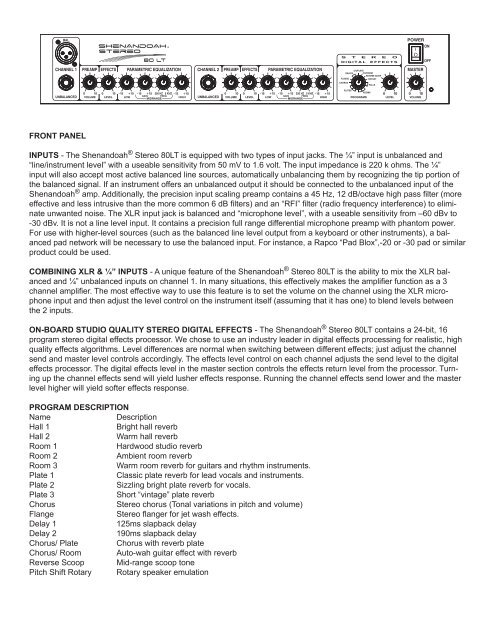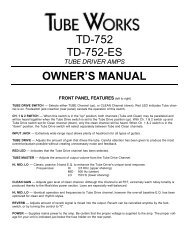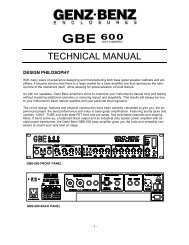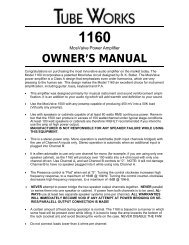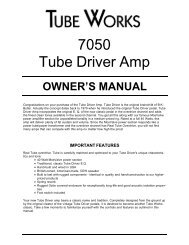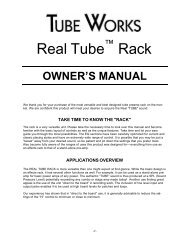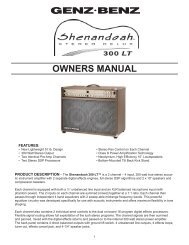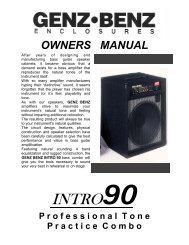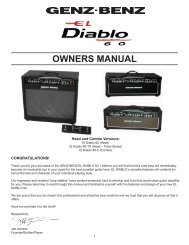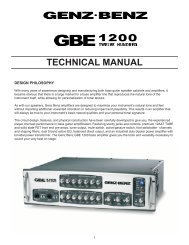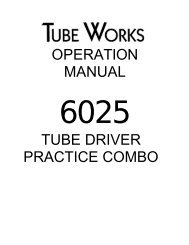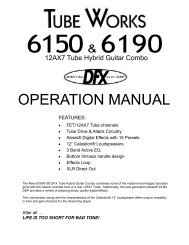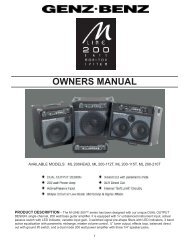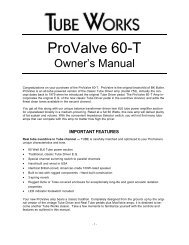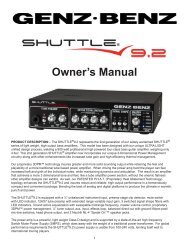Shenandoah 80LT Manual - Genz Benz
Shenandoah 80LT Manual - Genz Benz
Shenandoah 80LT Manual - Genz Benz
You also want an ePaper? Increase the reach of your titles
YUMPU automatically turns print PDFs into web optimized ePapers that Google loves.
FRONT PANEL<br />
INPUTS - The <strong>Shenandoah</strong> ® Stereo <strong>80LT</strong> is equipped with two types of input jacks. The ¼” input is unbalanced and<br />
“line/instrument level” with a useable sensitivity from 50 mV to 1.6 volt. The input impedance is 220 k ohms. The ¼”<br />
input will also accept most active balanced line sources, automatically unbalancing them by recognizing the tip portion of<br />
the balanced signal. If an instrument offers an unbalanced output it should be connected to the unbalanced input of the<br />
<strong>Shenandoah</strong> ® amp. Additionally, the precision input scaling preamp contains a 45 Hz, 12 dB/octave high pass filter (more<br />
effective and less intrusive than the more common 6 dB filters) and an “RFI” filter (radio frequency interference) to eliminate<br />
unwanted noise. The XLR input jack is balanced and “microphone level”, with a useable sensitivity from –60 dBv to<br />
-30 dBv. It is not a line level input. It contains a precision full range differential microphone preamp with phantom power.<br />
For use with higher-level sources (such as the balanced line level output from a keyboard or other instruments), a balanced<br />
pad network will be necessary to use the balanced input. For instance, a Rapco “Pad Blox”,-20 or -30 pad or similar<br />
product could be used.<br />
COMBINING XLR & ¼” INPUTS - A unique feature of the <strong>Shenandoah</strong> ® Stereo <strong>80LT</strong> is the ability to mix the XLR balanced<br />
and ¼” unbalanced inputs on channel 1. In many situations, this effectively makes the amplifier function as a 3<br />
channel amplifier. The most effective way to use this feature is to set the volume on the channel using the XLR microphone<br />
input and then adjust the level control on the instrument itself (assuming that it has one) to blend levels between<br />
the 2 inputs.<br />
ON-BOARD STUDIO QUALITY STEREO DIGITAL EFFECTS - The <strong>Shenandoah</strong> ® Stereo <strong>80LT</strong> contains a 24-bit, 16<br />
program stereo digital effects processor. We chose to use an industry leader in digital effects processing for realistic, high<br />
quality effects algorithms. Level differences are normal when switching between different effects; just adjust the channel<br />
send and master level controls accordingly. The effects level control on each channel adjusts the send level to the digital<br />
effects processor. The digital effects level in the master section controls the effects return level from the processor. Turning<br />
up the channel effects send will yield lusher effects response. Running the channel effects send lower and the master<br />
level higher will yield softer effects response.<br />
PROGRAM DESCRIPTION<br />
Name<br />
Description<br />
Hall 1<br />
Bright hall reverb<br />
Hall 2<br />
Warm hall reverb<br />
Room 1<br />
Hardwood studio reverb<br />
Room 2<br />
Ambient room reverb<br />
Room 3<br />
Warm room reverb for guitars and rhythm instruments.<br />
Plate 1<br />
Classic plate reverb for lead vocals and instruments.<br />
Plate 2<br />
Sizzling bright plate reverb for vocals.<br />
Plate 3<br />
Short “vintage” plate reverb<br />
Chorus<br />
Stereo chorus (Tonal variations in pitch and volume)<br />
Flange<br />
Stereo flanger for jet wash effects.<br />
Delay 1<br />
125ms slapback delay<br />
Delay 2<br />
190ms slapback delay<br />
Chorus/ Plate Chorus with reverb plate<br />
Chorus/ Room Auto-wah guitar effect with reverb<br />
Reverse Scoop Mid-range scoop tone<br />
Pitch Shift Rotary Rotary speaker emulation


